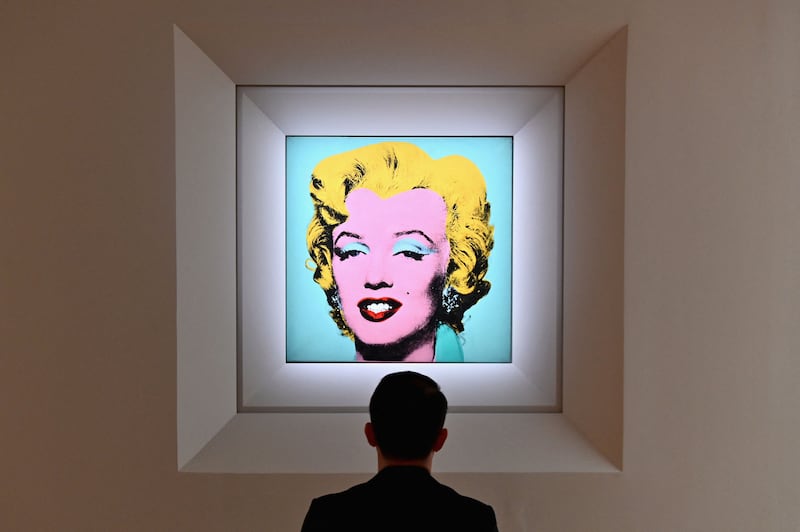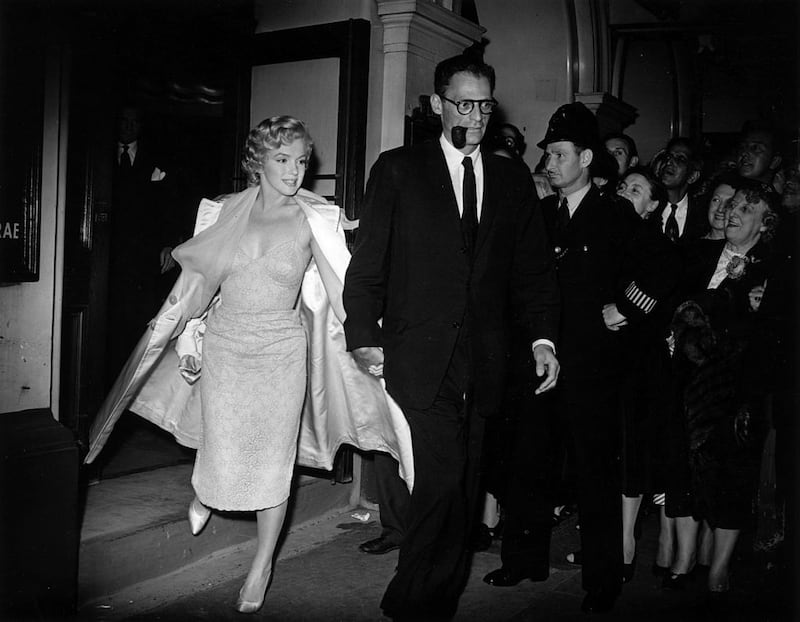In May a portrait of a woman sold at auction in New York for $195 million, or about €191 million — a record for an artwork by an American artist and by any artist in the 20th century. That month, also in New York, there was a furore when a dress the woman had once worn was paraded at the Metropolitan Museum of Art gala by a reality-TV star. The gown is said to be the most expensive dress in the world; its owner paid nearly $5 million for it. To ensure its safety it is normally kept in special conditions in a darkened vault.
The woman in the portrait, the woman who once wore the dress — to sing happy birthday to President John F Kennedy at Madison Square Garden — was, of course, Marilyn Monroe. The vividly coloured screenprint of her, the work of Andy Warhol, is the most famous of his works of pop art. Kim Kardashian, whose stunt it was to wear the Monroe dress at the Met, responded to criticism for having worn a deceased woman’s clothing by insisting, bizarrely, that she had “so much respect” for her.
In life Monroe made herself noticed far beyond Hollywood and in ways very different from the corny sex-bomb image that is the leitmotif of her modern iconography. Twenty years before physical exercise became a fad she went running. She read serious literature voraciously, Dostoevsky in particular. As early as 1950, studio executives had thought it necessary to warn her not to be seen reading politically radical books. Before the decade was out Monroe would marry Arthur Miller, at the very time the playwright was being investigated for his dalliance with communism. She supported the burgeoning US civil-rights movement. She was a founder member of the Hollywood branch of Sane, the Committee for a Sane Nuclear Policy.

Yet, 60 years after she died, Monroe’s vivid presence in the world’s culture — only Diana, Princess of Wales rivals her hold over the public imagination — does not allow for nuance. Massive sexpot street art of the star can be seen from Istanbul to Penang, Cannes to Vancouver. A silk Monroe hair scrunchie celebrating her “authenticity, self-acceptance and self-confidence” retails for €50. A “lifesize hyper-realistic silicone figurine statue” is a snip at just under€15,500.
Monroe is still a lucrative — and helpfully mutable — asset. The Montblanc Marilyn Monroe Special Edition Pearl ballpoint pen is yours for €775. A lamp featuring Monroe with the wind blowing her skirt up is just €180. Across the planet, Monroe’s features decorate everything from cookery books to coffee mugs, handbags to ties. Innumerable Facebook groups, Pinterest boards, Instagram accounts and fansites — Marilyn Remembered, Our Marilyn, Immortal Marilyn, the Irish Marilyn Monroe Fan Club — are devoted to her.
I wrote a biography of the star in 1985, seeking to penetrate the jungle of factoids about her and emerge with something approximate to the truth about her life and controversial death. Since its publication, the appetite for all things Monroe — in particular the seamier side of her legacy — has only grown more voracious. In recent months millions have watched a Netflix documentary based on the interviews I taped for that book. In September Netflix will premiere Blonde, a highly anticipated fictional film starring Ana de Armas.
It is billed as a biopic — and, by its director, Andrew Dominik, as an “emotional nightmare fairytale”. It is adapted from the novel of the same name by the American author Joyce Carol Oates, which was published in 2000. The novel, Oates wrote in a preface, was a “radically distilled ‘life’ of Marilyn Monroe”. By radically distilled, she explained, she meant that she had been highly selective, used real-life facts and characters — she credited my biography as being one of her main sources — but freely imagined much else.
In Oates’ 700-page novel the lead character is usually named as Norma Jeane, the name Monroe was born with and known by until her movie career took off. Later she is Marilyn Monroe. During the second World War the novel’s Norma Jeane works at Radio Plane, a company doing war work — and the future star did work at such a company. Later, when she finds fame, she marries first “the ex-athlete” and then “the playwright” — transparent references to Monroe’s husbands Joe DiMaggio and Arthur Miller.
Sexual experiences, mostly miserable ones, dominate Blonde — with an emphasis on the tyranny and treachery of many of her men. Early in the book Norma Jeane is raped by a Hollywood studio mogul who is allotted the name Mr Z. The rape scene is graphically written, sparing no detail. Mr Z has been interpreted as a thinly veiled reference to the founder of Twentieth Century Fox, Darryl Zanuck. The real-life Monroe recalled “casting couch” sex encounters, but nothing suggests any of them was with Zanuck. In interviews with almost 700 people I encountered nothing to suggest that any Hollywood producer raped Monroe.
In Oates’ novel, though, the most blatant historical libel targets Monroe’s 1962 involvement with “the president”. “The president”, from a hugely wealthy Irish-American family, is a clear reference to Kennedy. In the novel the president asks peremptorily to see Monroe, has sex with her repeatedly, then becomes inaccessible until “the summons” comes again.
Monroe is flown to the White House. There is more sex, chitchat about communist Cuba and Fidel Castro, and still more sex. Back in Los Angeles she dreams that the president has made her pregnant. Then comes another summons, another flight east. She sings “Happy birthday, Mr President” at Madison Square Garden. Then, on her return to Los Angeles, desolation and death.
In the novel death comes “hurtling toward her” in the form of a man “without passion and without pity”, an assassin. The man does not know whether his mission is “to protect the president from the president’s blond whore” or whether the real purpose is “to damage the president for being associated with the blond whore”. Using a key he has been given by a person identified as RF, the assassin gets into Monroe’s house at night when she is asleep. Then, equipped with a syringe loaded with a fatal dose of a sleeping medication, he sinks the “six-inch needle to the hilt into her heart”.
Oates’ novel makes it clear that references to “the president” in the book are to Kennedy. And no one would interpret her reference to RF as code for anyone other than RFK, the president’s brother, and attorney general, Robert F Kennedy.
Why do I call Oates’ “fictionalised” tale of dalliance with the Kennedys “historical libel”? Credible information does suggest that Kennedy dallied with Monroe. His brother Robert, research indicates, also had some sort of covert connection to her. There is zero evidence, however, that they or anyone else murdered her. Is it defensible to write and publish this scenario in a novel, not least when the individuals involved are still fresh in the memory? A scenario that could suggest the president’s brother aided and abetted — ordered? — murder?
When Oates’ novel came out her defence was that, in a work of fiction, she “had no particular obligation” to the facts. In my view that is not so. The people she named in her novel were real people with real reputations — and historical legacies — and such fictional fabrication is unjustifiably cruel. The fact that the individuals concerned are dead is no defence.

Will the upcoming movie spin the same tale? Dominik has said the film will be “critical of American sacred cows”, including Kennedy, and that “there’s something in it to offend everyone”. It is evident that the film will push the limits. Netflix reportedly insisted on hiring an editor to “curb the excesses” of the production. Even so, it has an NC-17 rating, which in theory bars viewing by anyone aged 17 or under in the United States.
Dominik does not mince his words. He says the movie is what you would want from “the NC-17 version of the Marilyn Monroe story”. He continues: “If the audience doesn’t like it, that’s the audience’s f**king problem.” More soberly, he claims the movie would not have been made without the #MeToo movement; that it tells what it is like “to be an unloved girl, to go through the Hollywood meat-grinder… how a childhood trauma shapes an adult who’s split between a public and private self”.
After seeing a rough cut Oates deemed the film “brilliant, very disturbing, perhaps most surprisingly an utterly ‘feminist’ interpretation”. Dominik has since ventured that “Blonde will be one of the 10 best movies ever made”.
“The scale of the Monroe myth is impossible to measure,” Prof Sarah Churchwell has written. More books have been written about the star than about any other entertainer. More than 20 films already offer a fictional version of her life story. Will the coming film be an indulgent wallow in her sex life and in conspiratorial fantasising about her death, or deliver something worthwhile?
John Huston, who directed Monroe’s first substantial movie, The Asphalt Jungle, from 1950, as well as the last one she completed, The Misfits, from 1961, said: “People say Hollywood broke her heart, but that is rubbish — she was observant and tough-minded… In certain ways she was very shrewd.” He added: “She went right down into her personal experience for everything, reached down and pulled something out of herself that was unique… She found things about womankind in herself.”
“How do you go about writing a life story?” Monroe herself wondered during an interview just before she died. “Because the true things rarely get into circulation. It’s usually the false things… It’s hard to know where to start, you know, if you don’t start with the truth.” — Guardian
Anthony Summers is the author of Goddess: The Secret Lives of Marilyn Monroe. An updated edition has just been published by Weidenfeld & Nicolson









